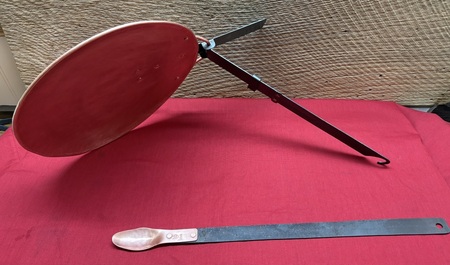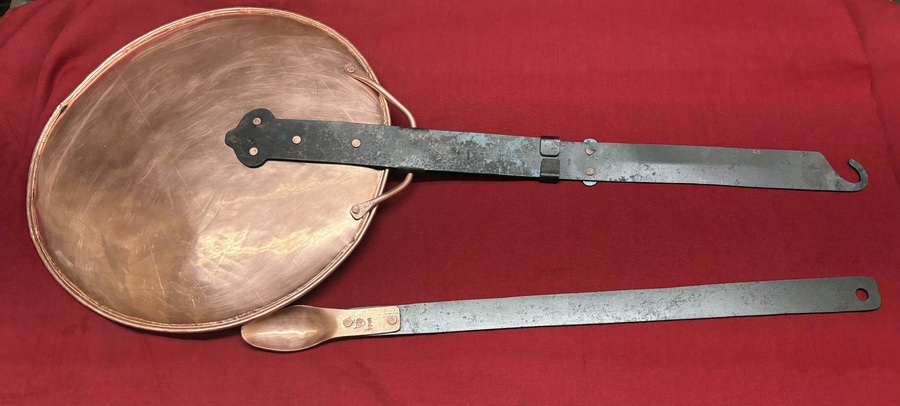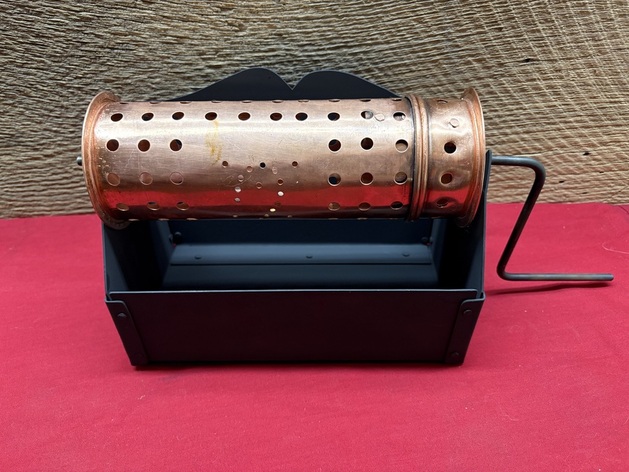Coffee, Tea, Chocolate, and Spirits

On This Page:
Muddler
Flip Knife
Beer Warmer
Mulling Iron
Birch Oil Extractor
Coffee Pot
Chocolate Pot
Tea Pot
Tea Strainer
Tea Caddy Spoon
Tea Caddy
Octagonal Tea Caddy
Mulling Cone and Brandreth
Ale Shoe
Sylabub Mixer
Sarbotiere
Flit
Ca. 1703 Chocolate Pot
Ale Spike
Coffee and Chocolate Bean Roaster
Gentleman's Folding Handle Coffee Pot
Bottle Stand
Still
Worm Tub
Basic Still Set
Alembic and Cucerbit
Cork Drawer
Montieth
Wine Thief and Dipping Dog
Punch Strainer



this story starts about 7000 bc in Ethiopia or thereabouts when a goatherd notices his flock being frisky after eating these big red berries about the size of grapes. The cherries give a pick me up if eaten raw, but are really fiberous. The ancients called them niter aethiopicus, or qauwah. The cherries can be ground into a tea called cascara but the real goodies are in the two beans inside. Dried a bit , then open roasted on a copper pan,about 1300 or so, the beans are crushed and added to boiling water and we get coffee.
My pan is about 13-1400 period, 11 inches diameter with a folding hande overall 24 inches..the spoon, more of a stirrer is about 18 inches long..$225.00 the pair
The early roaster is taken from about 1650 to about 1765, and measures 31/2 diameter and 9 inches long. The base is 9 3/4 long. 3 inches deep and overall about 6 1/2 tall. This also is early, while later styles have legs, drawers, and larger cylinders, this probably sat on some slate or a flat rock, it takes somewhere under 22 minutes to ROAST coffee properly.
Today we bake the beans in closed cylinders and lose the roasted flavor.
The early roaster .$325.00
The French put ground beans in small linen bags to deal with the grounds in your cup in 1710.
Beans roast best at 350-480 degrees F.


This copies a fifth century Roman filter for a straw..your spiked fruit punch was probably full of pulp and seeds, so a filter was attached to your straw to keep out the nasties.
Brass, from Roman originals... straw with filter ..$45.00
Click To Send Us An Email

Flip Knife (two shown above)
A delicate version of a mulling iron used to warm up a delicate glass of flip, or mulled wine, or whatever. Copied from numerous originals, ours are 16 inches long with a 3/4 x 3 thin blade, fully made from forged iron.
Flip Knife: $45.00

Beer Warmer (above)
Spiced warm beer was a German favorite. 12 ounces of good dark beer, 3 ounces of rum, some molasses and cinnamon and nutmeg and you are good to go. This was warmed up and put in a table or serving flaggon to keep the next serving from getting cold. From a German 18th century original. Forged iron.
Beer Warmer: $60.00

Mulling Iron (above)
Used to heat your spiced wine, burning or carmelizing the sugars for a different flavor. Reproduced from mid-18th century originals. Measures about 18 inches long, with a 3/4 inch cob to hold the heat.
Mulling Iron: $45.00

Birch Oil Extractor (above)
My version of a small oil still to produce oil from birch bark. This is used medicinally as it smells and tastes like wintergreen, and also waterproofs leather, acts as a wood finish and a no rust oil for metal.
Cooked down to a tar, it served to hold spear and arrowheads as far back as the Neanderthals. Used throughout Rome as a flexible waterproof glue. Birch tar held canoes together too. Instructions included.
Dimensions: 6 x 8 top, on a 3 x 2 3/4 collection pot. Historically inspired. All copper, made at a 1700 technology level.
Birch Oil Extractor: $325.00

Coffee Pot (above)
Handmade by Peter Goebel. Historic reproduction.
These pots were "serving pots"; coffee was never brewed in them. The coffee would be brewed in a large kettle over the fire, then transferred into these pots for serving at the table. Typically, the pot would be set on a brazier to keep warm. These pots were used in the same way a carafe is used in restaurants today. They are quite small, intended for the use of only a few people, and refilled as needed. Remember too, that coffee was served in small cups - not the mega mugs we are accustomed to today! Copper with tin lining. Sturdy hand turned wood handle. This is a very lovely piece, sure to make any coffee-break special! Dated: 18th century Origin: English. Materials: copper, tin, various woods as available. Dimensions: Large: 5" dia. base, 8"tall, capacity 5 1/2 cups. Small: 4" dia. base, 5 " tall, capacity 3 cups.
Large: $334
Small: $325.00
Hinged lid upgrade $65.00

Chocolate Pot (above)
Handmade by Peter Goebel. Historic reproduction.
Chocolate was a favorite drink in the 18th century - as it is now! This pot probably would not have been set on a fire; rather, hot water would have been combined with the ingredients and then stirred with the paddle. The pot would have then been placed on a brazier to keep warm at the table. Hot chocolate was served in the same manner as coffee and tea, that is in small cups that were refilled (frequently, I imagine!). The muller is based on European styles.
Date: ca. 1740. Origin: English. Materials: copper, tin, various woods as available.
Dimensions: Large: 5" diameter base, 8" tall, capacity is 5 1/2 cups.
Small: 4" diameter base, 5" tall, 3 cup capacity.
Large: $350.00
Small: $335.00
Upgrade: Hinged Lid: $65.00
Additional Muller: $40.00

Tea Pot (above)
Handmade by Peter Goebel. Historically inspired.
This teapot was inspired by 18th and 19th century designs. Heavy guage copper, tin lined. It has a bail, as well as a handle. Lid has a ring. The wide base of this style pot boils water in a hurry! Dated: 18th & 19th century inspired, Origin: English/American.
Dimensions: Large: 10 1/2" dia., 11 cups. Medium: 8" dia., 7 cups. Small: 6" dia., 3 cups.
Large: $255.00
Medium: $235.00
Small: $210.00

Tea Strainer (above)
Handmade by Peter Goebel. Historic reproduction.
This is a copy of an original dating from the late 17th century to the early 18th century. Hand hammered heavy brass with a pierced bowl. This is a pretty piece. Dated: late 17th, early 18th century. Origin: English. Materials: brass. Dimensions: 4" X 6 1/2".
Tea Strainer: $125.00

Tea Caddy Spoon (above)
Handmade by Peter Goebel. Historic reproduction.
Reproduced from an original piece dating to the mid 18th century. This is a nice addition to your tea service. Loose tea was poured from the caddy, into this spoon, and added to the simmering water. Dated: 18th century. Origin: English. Materials: brass. Dimensions: 3 7/8", 2 1/8" diameter bowl.
Tea Caddy Spoon: $80.00

Rectangular Tea Caddy (above)
Handmade by Peter Goebel. Historic reproduction.
Tea was stored in "caddies" such as this (others may have been made of wood, china, earthenware, and other materials). Ours is made of tin lined brass, or tin lined copper. It has a friction fit lid. Dated: 18th century. Origin: English. The caddy measures 2 3/4 x 4, x 3 1/4 tall...the spout is about an inch tall
Rectangular Tea Caddy in Tin-Lined Copper: $150.00
Rectangular Tea Caddy in Tin-Lined Brass: $150.00

Octagonal Tea Caddy (above)
Handmade by Peter Goebel. Historic reproduction.
This was a very popular shape for 18th century caddies. Its octagonal form reflects the Chinese influence of the period. Dated: circa 1750. Materials: tin, copper or brass. Dimensions: 5" across, 6" tall, 1" tall spout.
Octagonal Tea Caddy in Tin-Lined Brass: $200.00
Octagonal Tea Caddy in Tin-Lined Copper: $200.00

Mulling Cone and Brandreth (above)
Handmade by Peter Goebel. Historic reproduction.
This beautiful piece dates from the late 17th to the mid 18th century. A mulling cone was used to warm drinks. As its name suggests, it is conical in shape. It has a wired rim. All pieces are tin lined copper. It's companion piece, a brandreth, is included. The brandreth holds the mulling cone in an upright postion so that hot coals could be raked under it. It is made of hand forged iron. Three sturdy legs are riveted in place. The brandreth can double as a trivet for smaller pots and sauce pans. Dated: 1600-1750. Origin: English. Materials: coper, tin, wood, iron. Dimensions: 6" dia. X 10 1/2" tall. Brandreth is 8" tall.
This piece was featured in Tim Burton's Alice in Wonderland!
Mulling Cone and Brandreth: $350.00

Ale Shoe (above)
Handmade by Peter Goebel. Historic reproduction.
This is a nifty eighteenth-century piece which was used to warm ale and other beverages. It looks like a shoe with a lid! The drink was poured into the "shoe", and the "toe" was nestled in the hot coals. When warmed, the drink would be poured into individual glasses. Sturdy construction of tin lined copper. Dated: 18th century. Origin: English. Materials: copper, tin. Dimensions: 4" diameter by 10" long, 4 and 2/3 cup capacity. And don't forget to lant that ale!
Ale Shoe: $500.00

Sylabub Mixer (above*)
Handmade by Peter Goebel. Historic reproduction.
Sylabub was a favorite 18th century drink, so popular that this mixer was devised just for the purpose of creating it! The "churner" makes quick work of whipping up this beverage. We've heard from customers that it also works for butter and whipped cream! Tight fitting friction fit lid, wooden handled agitator. Dated: 18th century. Materials: copper, various woods as available. Dimensions: 3 1/2" dia. x 14" tall.
*Shown lightly antiqued.
Sylabub Mixer: $290.00


Sarbotiere (two images above)
Handmade by Peter Goebel. Historic reproduction.
Thomas Jefferson brought recipes for "iced cream" home from France. He made them in this "sarbotiere", or ice cream maker! If you have ever made ice cream the "rolling tin can way", you will understand the principle behind this 18th century version! The lid is tightly fitting. What's better than ice cream? Homemade ice cream!
Dated: 18th century. Origin: French/American. Materials: copper. Dimensions: 5 1/2" diameter by 12" tall.
Sarbotiere: $195.00

Flit (above)
Handmade by Peter Goebel. Historic reproduction.
Copied from an original, flits were used to skim cream off the top of milk. Perforations in the bowl allow the milk to drain from the cream. Heavy copper or brass. Dated: 18th century. Origin: English/American. Materials: copper or brass. Dimensions: 6" dia.
Flit: $65.00

Ca. 1703 Chocolate Pot (above)
Handmade by Peter Goebel. Historic reproduction.
Recreated from an original in the collection of Fortress Louisbourg. French and Dutch specimens exist with some handle variations. This style seems to have been popular 1690-1720. Made with heavy tin-lined copper and rolled rivets, forged handle and maple grip. Comes with a wooden muller to stir the chocolate.
1703 Chocolate Pot: $395.00

Ale Spike (above*)
Handmade by Peter Goebel. Historic reproduction.
Ale spikes, or mulling cones, were used to keep your beer warm ... only a heathen would drink good beer cold! This piece has been copied from an original in a private collection and dated to about 1750-1875. Made in fully tin-lined copper, our ale spike is "single-serving" sized.
*Shown lightly antiqued.
Ale Spike: $170.00

Coffee and Chocolate Bean Roaster (above)
Handmade by Peter Goebel. Historic reproduction.
A generic style, copied from many existing pieces, and used from the late 17th century through the early 19th. Wooden handle on a 44 - inch steel rod (either round or square) with the can fastened about a foot from the end. Roaster is about 4 1/2" by 8". Materials: copper, iron and wood.
Coffee and Chocolate Bean Roaster: $295.00
Due to length of handle, ships in 2 boxes

Gentleman's Folding Handle Coffee Pot (above*)
Handmade by Peter Goebel. Historic reproduction.
Copied from a silver original designed to fit into a portmanteau. Perfect for taking a cup of coffee up to your tavern room. Tin lined, silver brazed copper with a slight taper and a folding handle. Measures 2 and 3/4" across the base, 2 and 1/4" across the top, and is 5 and 5/8" tall. Friction fit lid.
*Shown lightly antiqued.
Gentleman's Folding Handle Coffee Pot: $235.00

Bottle Stand (above)
Handmade by Peter Goebel. Historic reproduction.
A useful piece to keep a cool bottle from sweating on your table! Sometimes these were painted or japanned. If you wish, gluing a felt pad on the bottom will turn the bottle stand into a period "coaster" that now may be slid or coasted across a table. Dimensions: 7" diameter by 1 1/4" tall. Dated to 1690-1770. Bottle not included.
Bottle Stand, Copper: $65.00

Miniature Coffee Pot (above, right, and above, left, with large and medium coffee pots for comparison)
Handmade by Peter Goebel. Historically inspired. Copied from a ca. 1730 Georgian silver original with a 1 cup capacity.
Copper. Measures 3 and 1/2 at base, top is 1 and 3/4 inches in diameter, and is about 5 and 1/4 tall. Capacity is 1 cup, but it pours better at 3/4 cup.
It's like jewelry!
Miniature Coffee Pot: $255.00
NOTE ~ Side-handled pots pour towards yourself, that way you can see into the tea or coffee bowl.

Basic Still Set (above)
Handmade by Peter Goebel. Reproduced from a number of originals.
Just what any self-respecting apothecary, surgeon, doctor, alchemist, naturalist or farm wife needs to distill essential oils! Dating from 3,400 BC to today, this simple still was used all over the world.
In use, chopped herbs are covered with water and the and the mixture is brought to a boil inside the base. Once boiling, the mixture is lowered to a simmer and cone lid is put on. Condensate develops inside the cone, collects inside the gutter, and runs out the spout. Condensate can be helped along by wrapping a cold damp cloth over the cone lid. The condensate is a hydrosol, a misture of oils and water which will separate on its own - at which time, the oils can be spooned off the top. Both the oil and the water would have been used in the past - over 200 different oils were distilled in Colonial America.
This still and its lid are made entirely of unlined copper. Together, the still and lid measure 18" tall, with a 7 3/4" diameter base. The set includes the still, the conical lid .
Basic Still Set: $525.00

Alembic and Cucerbit (above)
Handmade by Peter Goebel. Historically inspired.
The most iconic still there is, recognizable to both Ramses I and Isaac Newton. This simple style is still in use today!
The cucerbit, the conical base, is solid unlined copper and measures 8" tall, 2 3/4 diameter at the top, and 6" diameter at the base. The alembic head, also made of unlined copper, is 4 3/4 wide, 5" tall, and has a 6" spout. The overall height of the set in use is about 12 3/4". The set holds about six cups or 1 1/2 quarts.
Alembic and Cucerbit: $575.00

Cork Drawer (above)
Imported. Historic Reproduction. From a mid 18th c original.
Made of solid brass and steel, this handy little piece is elegant, useful, and will last a lifetime, no jokes. Cleverly constructed in two pieces; the cover for the drawer screws off and can be put through the loop in the top for a handle that gives leverage. It's the perfect piece to pack for a picnic.
Measures 4 1/4 inches long, and 2 3/4 inches wide when assembled. Weighs 4 oz.
Cork Drawer: $47.00

Bottle Tag and Chain (above)
A classy way to label your bottles. Reproduced in heavy brass and copper.
Bottle Tag and Chain: $70.00

Monteith (above)
The magnificent Montieth. A fantastic centerpiece for the holiday table. Made for cooling glasses as well as bottles of wine in an ice water bath. Fashioned from about 8 pounds of solid copper. It measures 15 1/2 diameter, by 5 1/2 inches deep. Reproduced from originals 1680 to 1725, still made through the American Civil War.
Monteith: $485.00

Wine Thief (above)
The wine thief is the long tapered device used not to steal, but to sample wines in the kegs. Inserted in the bung, by putting your finger over the hole it withdraws a quantity of wine to sample. Tin lined copper, late 18th century reproduced from dozens of examples. Measure 16 inches long x 1 1/2 at widest point.
Wine Thief: $122.00
Dipping Dog (above)
This little device was lowered into a cask of whiskey with the intent of stealing a drink for later on. Tin lined copper 1 1/2 diam. x 6 inches tall, corked and complete with hand made chain leash. Holds 2/3 of a cup.
Dipping Dog: $90.00

Punch Strainer (above)
Taken from a number of originals in silver, ours measures about 12 inches by 4 1/2 with a 1 inch deep bowl. Hand cut from heavy brass, it is stylistically dated to the first half of the 18th century.
Punch Strainer: $240.00
Back to Top
|




































